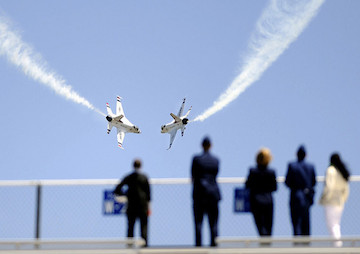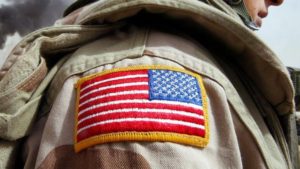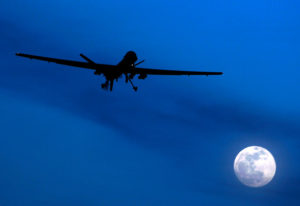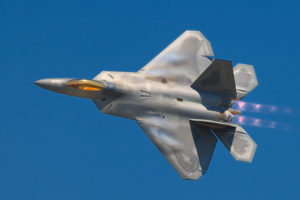Dominating the Skies — and Losing the Wars
U.S. pilots have total mastery of the fabled “high ground” of war. And yet throughout the Greater Middle East, America’s conflicts rage on with no endgame in sight. Two U.S. Air Force Thunderbirds execute a maneuver at the U.S. Air Force Academy's Falcon Stadium. (Beverly & Pack / CC-BY-2.0)
1
2
3
Two U.S. Air Force Thunderbirds execute a maneuver at the U.S. Air Force Academy's Falcon Stadium. (Beverly & Pack / CC-BY-2.0)
1
2
3

Two U.S. Air Force Thunderbirds execute a maneuver at the U.S. Air Force Academy’s Falcon Stadium. (Beverly & Pack / CC-BY-2.0)
In the era of the long war on terror, Thursday, June 2nd, 2016, was a tough day for the U.S. military. Two modern jet fighters, a Navy F-18 Hornet and an Air Force F-16 Fighting Falcon, flown by two of America’s most capable pilots, went down, with one pilot killed. In a war that has featured total dominance of the skies by America’s intrepid aviators and robotic drones, the loss of two finely tuned fighter jets was a remarkable occurrence.
As it happened, though, those planes weren’t lost in combat. Enemy ground fire or missiles never touched them nor were they taken out in a dogfight with enemy planes (of which, of course, the Islamic State, the Taliban, and similar U.S. enemies have none). Each was part of an elite aerial demonstration team, the Navy’s Blue Angels and the Air Force’s Thunderbirds, respectively. Both were lost to the cause of morale-boosting air shows.
Each briefly grabbed the headlines, only to be quickly forgotten. Americans moved on, content in the knowledge that accidents happen in risky pursuits.
But here’s a question: What does it say about our overseas air wars when the greatest danger American pilots face involves performing aerial hijinks over the friendly skies of “the homeland”? In fact, it tells us that U.S. pilots currently have not just air superiority or air supremacy, but total mastery of the fabled “high ground” of war. And yet in Afghanistan, Iraq, and elsewhere in the Greater Middle East, while the U.S. rules the skies in an uncontested way, America’s conflicts rage on with no endgame in sight.
In other words, for all its promise of devastating power delivered against enemies with remarkable precision and quick victories at low cost (at least to Americans), air power has failed to deliver, not just in the ongoing war on terror but for decades before it. If anything, by providing an illusion of results, it has helped keep the United States in unwinnable wars, while inflicting a heavy toll on innocent victims on our distant battlefields. At the same time, the cult-like infatuation of American leaders, from the president on down, with the supposed ability of the U.S. military to deliver such results remains remarkably unchallenged in Washington.
America’s Experience with Air Power
Since World War II, even when the U.S. military has enjoyed total mastery of the skies, the end result has repeatedly been stalemate or defeat. Despite this, U.S. leaders continue to send in the warplanes. To understand why, a little look at the history of air power is in order.
In the aftermath of World War I, with its grim trench warfare and horrific killing fields, early aviators like Giulio Douhet of Italy, Hugh Trenchard of Britain, and Billy Mitchell of the United States imagined air power as the missing instrument of decision. It was, they believed, the way that endless ground war and the meat grinder of the trenches that went with it could be avoided in the future. Unfortunately for those they inspired, in World War II the skies simply joined the land and the seas as yet another realm of grim attrition, death, and destruction.
Here’s a quick primer on the American experience with air power:
* In World War II, the U.S. Army Air Forces joined Britain’s Royal Air Force in a “combined bomber offensive” against Nazi Germany. A bitter battle of attrition with Germany’s air force, the Luftwaffe, ensued. Allied aircrews suffered crippling losses until air superiority was finally achieved early in 1944 during what would be dubbed the “Big Week.” A year later, the Allies had achieved air supremacy and were laying waste to Germany’s cities (as they would to Japan’s), although even then they faced formidable systems of ground fire as well as elite Luftwaffe pilots in the world’s first jet fighters. At war’s end, Allied losses in aircrews had been staggering, but few doubted that those crews had contributed immeasurably to the defeat of the Nazis (as well as the Japanese).
* Thanks to air power’s successes in World War II (though they were sometimes exaggerated), in 1947 the Air Force gained its independence from the Army and became a service in its own right. By then, the enemy was communism, and air power advocates like General Curtis LeMay were calling for the creation of a strategic air command (SAC) made up of long-range bombers armed with city-busting thermonuclear weapons. The strategy of that moment, nuclear “deterrence” via the threat of “massive retaliation,” later morphed into “mutually assured destruction,” better known by its telling acronym, MAD. SAC never dropped a nuclear bomb in anger, though its planes did drop a few by accident. (Fortunately for humanity, none exploded.) Naturally, when the U.S. “won” the Cold War, the Air Force took much of the credit for having contained the Soviet bear behind a thermonuclear-charged fence.
* Frustration first arrived full-blown in the Korean War (1950-1953). Primitive, rugged terrain and an enemy that went deep underground blunted the effectiveness of bombing. Flak and fighters (Soviet MiGs) inflicted significant losses on Allied aircrews, while U.S. air power devastated North Korea, dropping 635,000 tons of bombs, the equivalent in explosive yield of 40 Hiroshima bombs, as well as 32,557 tons of napalm, leveling its cities and hitting its dams. Yet widespread bombing and near total air superiority did nothing to resolve the stalemate on the ground that led to an unsatisfying truce and a Korea that remains bitterly divided to this day.
Your support matters…Independent journalism is under threat and overshadowed by heavily funded mainstream media.
You can help level the playing field. Become a member.
Your tax-deductible contribution keeps us digging beneath the headlines to give you thought-provoking, investigative reporting and analysis that unearths what's really happening- without compromise.
Give today to support our courageous, independent journalists.








You need to be a supporter to comment.
There are currently no responses to this article.
Be the first to respond.